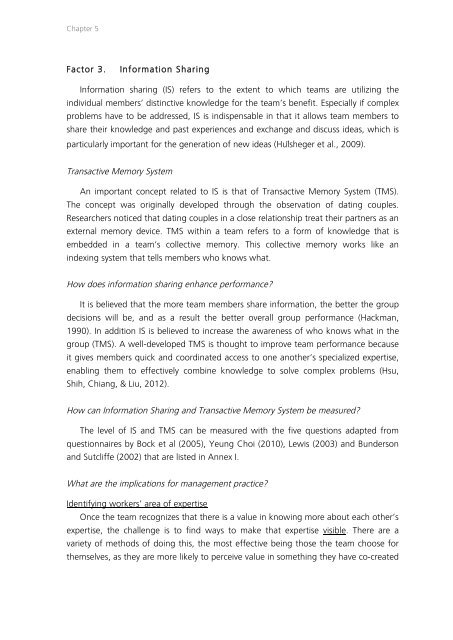In Search of Evidence
jqluvth
jqluvth
You also want an ePaper? Increase the reach of your titles
YUMPU automatically turns print PDFs into web optimized ePapers that Google loves.
Chapter 5<br />
Factor 3.<br />
<strong>In</strong>formation Sharing<br />
<strong>In</strong>formation sharing (IS) refers to the extent to which teams are utilizing the<br />
individual members’ distinctive knowledge for the team’s benefit. Especially if complex<br />
problems have to be addressed, IS is indispensable in that it allows team members to<br />
share their knowledge and past experiences and exchange and discuss ideas, which is<br />
particularly important for the generation <strong>of</strong> new ideas (Hülsheger et al., 2009).<br />
Transactive Memory System<br />
An important concept related to IS is that <strong>of</strong> Transactive Memory System (TMS).<br />
The concept was originally developed through the observation <strong>of</strong> dating couples.<br />
Researchers noticed that dating couples in a close relationship treat their partners as an<br />
external memory device. TMS within a team refers to a form <strong>of</strong> knowledge that is<br />
embedded in a team’s collective memory. This collective memory works like an<br />
indexing system that tells members who knows what.<br />
How does information sharing enhance performance?<br />
It is believed that the more team members share information, the better the group<br />
decisions will be, and as a result the better overall group performance (Hackman,<br />
1990). <strong>In</strong> addition IS is believed to increase the awareness <strong>of</strong> who knows what in the<br />
group (TMS). A well-developed TMS is thought to improve team performance because<br />
it gives members quick and coordinated access to one another’s specialized expertise,<br />
enabling them to effectively combine knowledge to solve complex problems (Hsu,<br />
Shih, Chiang, & Liu, 2012).<br />
How can <strong>In</strong>formation Sharing and Transactive Memory System be measured?<br />
The level <strong>of</strong> IS and TMS can be measured with the five questions adapted from<br />
questionnaires by Bock et al (2005), Yeung Choi (2010), Lewis (2003) and Bunderson<br />
and Sutcliffe (2002) that are listed in Annex I.<br />
What are the implications for management practice?<br />
Identifying workers’ area <strong>of</strong> expertise<br />
Once the team recognizes that there is a value in knowing more about each other’s<br />
expertise, the challenge is to find ways to make that expertise visible. There are a<br />
variety <strong>of</strong> methods <strong>of</strong> doing this, the most effective being those the team choose for<br />
themselves, as they are more likely to perceive value in something they have co-created


